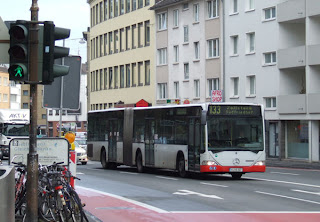 Köln, also known as Cologne, is one of Germany's largest cities with around 1 million inhabitants. Straddling the River Rhine, it is probably best known for its Gothic Cathedral and as the place where Eau de Cologne was first produced. During Advent, the city hosts several traditional German Christmas Markets.
Köln, also known as Cologne, is one of Germany's largest cities with around 1 million inhabitants. Straddling the River Rhine, it is probably best known for its Gothic Cathedral and as the place where Eau de Cologne was first produced. During Advent, the city hosts several traditional German Christmas Markets.The city's main rail station is a major hub on the German and European railway network with regular high-speed trains to other cities across Germany as well as to Amsterdam, Brussels and Paris. Direct trains to London via the Channel Tunnel are being planned by both Deutsche Bahn and Eurostar, although it is likely to be at least another couple of years yet before either service starts operating.
Köln's transport network is coordinated by Verkehrsverbund Rhein-Sieg (VRS), a body whose responsibilities cover the entire region of Köln and neighbouring Bonn. Services are operated by a number of organisations in partnership with VRS.
Around 80 bus routes serve the city. However, very few buses are seen in the city centre. There has been ongoing investment in the light rail system, which is continuing. Most bus routes operate in the suburbs and outlying districts, providing connections to either the light rail system or an extensive network of suburban rail services.
 The light rail system is a network of tram lines. In the city centre, some operate underground, while others are on-street.
The light rail system is a network of tram lines. In the city centre, some operate underground, while others are on-street.

The on-street sections are generally segregated from general traffic although there are places where the roadspace is shared.
The light rail system is operated by Kölner Verkehrs-Betriebe (KVB)
Those buses which do serve the centre of Köln are a mix of standard and articulated single-deckers.
 Routes which are entirely within Köln are operated by KVB.
Routes which are entirely within Köln are operated by KVB. 





In some places, buses share the segregated tram lanes rather than the lanes for general traffic

KVB has begun trialling hybrid technology, with the first hybrid bus entering service in 2012.
Other services entering Köln from surrounding communities are operated by other providers as well as KVB. Irrespective of who operates them, all are covered by the VRS fares structure. All terminate alongside the main railway station.





 There are double-decker buses on the streets of Köln. These are confined to sightseeing tours.
There are double-decker buses on the streets of Köln. These are confined to sightseeing tours.
Köln is also home to a cable car, which crosses the Rhine slightly to the north of the city centre. It operates during the daytimes, serving visitor attractions, from early Spring to mid-Autumn.
 When I visited Köln in December 2012, a different form of transport had taken to the streets for the benefit of visitors. This road train linked the Christmas Markets around the city centre.
When I visited Köln in December 2012, a different form of transport had taken to the streets for the benefit of visitors. This road train linked the Christmas Markets around the city centre.




No comments:
Post a Comment